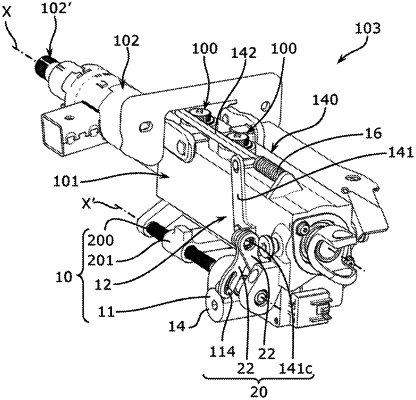| CPC B62D 1/181 (2013.01) [B62D 1/185 (2013.01)] | 14 Claims |

|
1. A steering column sleeve comprising (i) two elements that include an outer tube and an inner tube which are translationally mobile one with respect to the other along a reference axis, and (ii) an adjusting system for adjusting a relative position between the two elements, the adjusting system comprising:
an axial-position adjusting screw extending along an axis of adjustment parallel to the reference axis and translationally secured to a first of the two elements, the adjusting screw being engaged with a nut fixedly secured to a second of the two elements so that a rotation of the adjusting screw about the axis of adjustment causes a translational movement of the nut with respect to the adjusting screw;
a resistive-force adjusting device configured to adjust a resistive force that opposes relative translational movement between the outer tube and the inner tube, the resistive-force adjusting device comprising at least (i) a friction pad supported by the first of the two elements, and (ii) a clamping surface secured to the second of the two elements and against which the friction pad is in bearing contact, the friction pad being configured to move with respect to the clamping surface so as to vary a force with which the friction pad presses against the clamping surface between a service position in which a predetermined service pressure is applied by the friction pad to the clamping surface, and an adjusting position in which an adjustment pressure lower than the service pressure is applied by the friction pad to the clamping surface,
wherein the adjusting system further comprises (i) a motor configured to drive rotation of the adjusting screw and control the resistive-force adjusting device, and (ii) a kinematic chain configured so that beyond a threshold resistive torque transmitted by the adjusting screw to the motor, torque from the motor is transmitted at least in part to the resistive-force adjusting device so as to move the friction pad from its service position to its adjusting position.
|